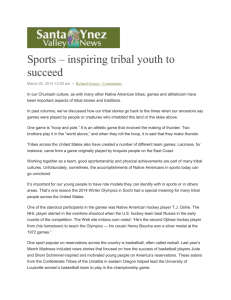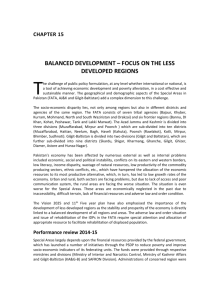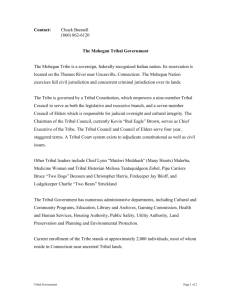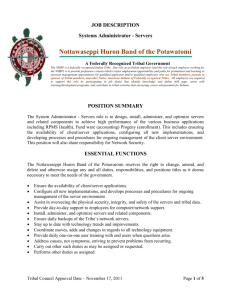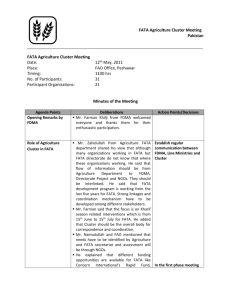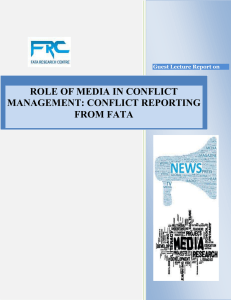Introduction to FATA
advertisement
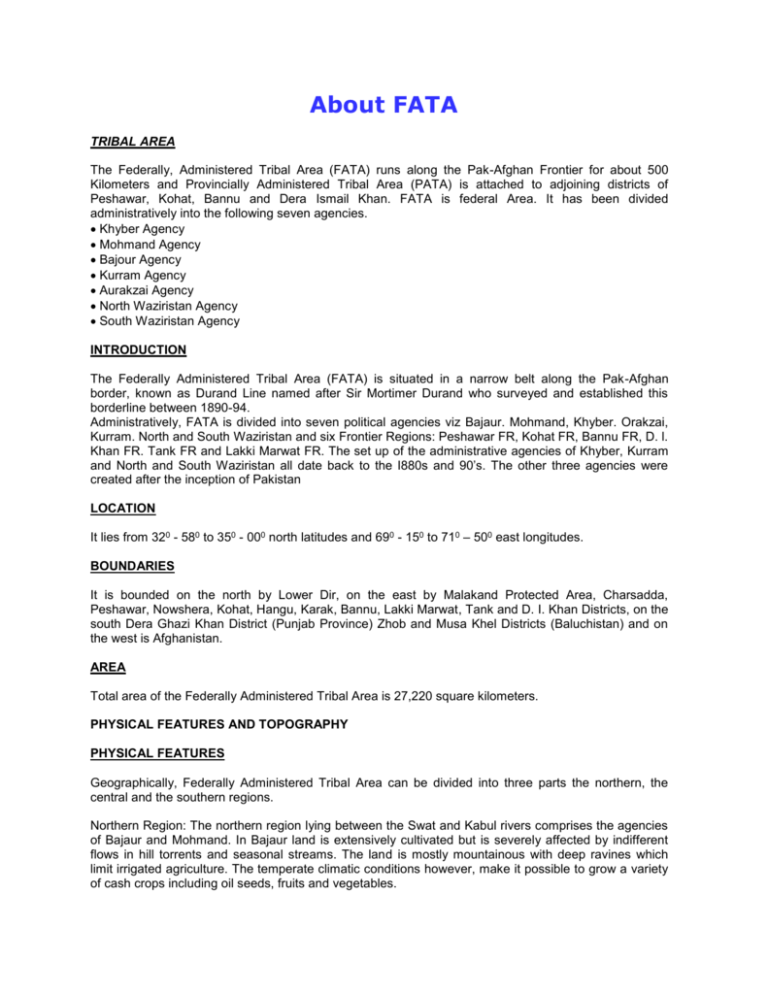
About FATA TRIBAL AREA The Federally, Administered Tribal Area (FATA) runs along the Pak-Afghan Frontier for about 500 Kilometers and Provincially Administered Tribal Area (PATA) is attached to adjoining districts of Peshawar, Kohat, Bannu and Dera Ismail Khan. FATA is federal Area. It has been divided administratively into the following seven agencies. Khyber Agency Mohmand Agency Bajour Agency Kurram Agency Aurakzai Agency North Waziristan Agency South Waziristan Agency INTRODUCTION The Federally Administered Tribal Area (FATA) is situated in a narrow belt along the Pak-Afghan border, known as Durand Line named after Sir Mortimer Durand who surveyed and established this borderline between 1890-94. Administratively, FATA is divided into seven political agencies viz Bajaur. Mohmand, Khyber. Orakzai, Kurram. North and South Waziristan and six Frontier Regions: Peshawar FR, Kohat FR, Bannu FR, D. l. Khan FR. Tank FR and Lakki Marwat FR. The set up of the administrative agencies of Khyber, Kurram and North and South Waziristan all date back to the I880s and 90’s. The other three agencies were created after the inception of Pakistan LOCATION It lies from 320 - 580 to 350 - 000 north latitudes and 690 - 150 to 710 – 500 east longitudes. BOUNDARIES It is bounded on the north by Lower Dir, on the east by Malakand Protected Area, Charsadda, Peshawar, Nowshera, Kohat, Hangu, Karak, Bannu, Lakki Marwat, Tank and D. I. Khan Districts, on the south Dera Ghazi Khan District (Punjab Province) Zhob and Musa Khel Districts (Baluchistan) and on the west is Afghanistan. AREA Total area of the Federally Administered Tribal Area is 27,220 square kilometers. PHYSICAL FEATURES AND TOPOGRAPHY PHYSICAL FEATURES Geographically, Federally Administered Tribal Area can be divided into three parts the northern, the central and the southern regions. Northern Region: The northern region lying between the Swat and Kabul rivers comprises the agencies of Bajaur and Mohmand. In Bajaur land is extensively cultivated but is severely affected by indifferent flows in hill torrents and seasonal streams. The land is mostly mountainous with deep ravines which limit irrigated agriculture. The temperate climatic conditions however, make it possible to grow a variety of cash crops including oil seeds, fruits and vegetables. Central Region: The central region comprises the Khyber, Kurram and Orakzai agencies and the Frontier Regions of Kohat and Peshawar. The Khyber Pass, which serves as a key international trade route, has promoted the development of a major service and retail industry in the area, providing employment for the tribesmen, In the foot hills of the 4,000 meters high snow clad Sufed Koh (White Mountain) lie the fertile Khanki Toe. Mastura River and the Bara River valleys. The Kurram valley has extensively cultivated agricultural land in Federally Administered Tribal Area. Kurram Agency also abounds in high hill coniferous forests. The Khyber hills, however, composed of carboniferous materials, are largely barren. The Kohat hills, which extend from the Kurram valley to the lndus, are equally barren but offer huge rock-salt deposits for commercial extraction. Southern Region: The southern region consists of the North and South Waziristan and the Frontier Regions of D. l. Khan, Tank, Bannu and Lakki. Towards the south of this region is the Gomal River while the Kurram River flows towards the north. The region is bound on its western side by the Afghan districts of Birmal and Khost and by the Bannu basin and Derajat on its east. Igneous rock formations in the Waziristan hills suggest a specifically active area, particularly in the Tochi valley around Datta Khel, and the Makin Kaniguram area, where also a number of important minerals are available in commercial quantities. SOIL The Federally Administered Tribal Area consists of four (4) major landform/ physiographic units such as piedmont plains/valleys, gravely fans/aprons, rough broken land/ gullied land and mountains. The plain areas of valleys are mainly of alluvial and partly loessic origin. The nearby level areas are loamy whereas the slightly low-lying lands are of clayey textured. They are homogenized with weak to moderate profile development and are slightly to strongly calcareous. The content of organic matter and available phosphorus is very low. The gravely fans and aprons are encountered near the foot-hills as the higher graded intermittent torrents/streams shed their load due to sudden decrease in velocity. The alluvium is composed of heterogeneous material with little soil. The natural vegetation is also scanty consisting of artemisia, kaloxylon and ziziphus special which are grazed by local animals. The rough broken and gullied lands are characterized by steep slope, active geological erosion and high run-off. The natural vegetation is spared. The mountains comprise sandstone, limestone, shale, quartzite, schist, Phyllis, diorite and conglomerates. High relief, steep slopes and severe erosion are the identifying feature of these units. There is a little soil cover on the mountains. The natural vegetation is of mixed type and its density depends upon the amount of rainfall and geological formation of the hills. HISTORY The areas constituting Federally Administered Tribal Area have held a unique position in the history of the Sub-Continent. The harsh mountain land interspersed with many passes, the most famous of these being the Khyber Pass, has over the centuries provided passage for invaders from the north. The Aryans entered India through these passes as did Alexander the Great. The British realizing the importance of this area, during the period of the Forward Policy of Lord Curzon, demarcated this area through the Durand Line as a buffer zone for their Indian Empire against the threat of the Tsarist Russia’s expansion. The demarcation of the area however, did not totally subsume the political autonomy of the region. Except where strategic considerations dictated, the area was allowed to exercise its peculiar administration based on tribal laws and institutions. One of the earliest references to this area and its people dates back to the invasion of Alexander the Great circa 323 B.C. in which a tribe called the Apurtae were said to inhabit the hills of the present Khyber Agency. The change of name to the present Apredai in the local dialect is not difficult to discern. The autonomous status of FATA was accepted by Pakistan on its independence through the famous Instrument of Accession signed by the Father of the Nation, Quaid-e-Azam Muhammad Ali Jinnah, at the Bannu Tribal Jirga in January 1948. The same has been enshrined in all constitutions of the Islamic Republic of Pakistan, including the Constitution of 1973 in its Article 247. Under Article 247 of the constitution of the Islamic Republic of Pakistan the Federally Administered Tribal Areas (FATA) fall under the executive authority of the Federation. In terms of Article 247 and the linked SRO 109 of 25/6/1970, administrative powers with respect to FATA vest in the President of Pakistan who has appointed the Governor North West Frontier Province to act as his Agent for FATA for exercise of executive authority in these areas, in such manner and to such extent as the President may from time to time direct. The Agent to the President is to he assisted in this function by the various heads of the line departments in their specific areas of administration. The exception outside the purview of the line departments of NWFP is the FATA Development Corporation supervised by a Board of Directors established to look after the development of industry, minerals and water resources in FATA. RACES AND TRIBES The Federally Administered Tribal Area (FATA) as its name suggests is characterized by a strong tribal structure. There are 11 major tribes with several small tribes and sub-tribes. The overwhelming majority of the population is Muslim with a sprinkling of minorities such as Sikhs, Hindus etc. Pushto is the main language with the softer dialect of ‘Pushto’ being spoken in the south and the more guttural dialect of Pakhtu spoken in north. A less spoken language is Urmari in the south. CULTURE DRESS AND ORNAMENTS The tribesmen generally wear loose shirt and trousers. A large turban is placed on the head with a chadar and rifle on shoulder. The women-folk generally use printed cloth. Their working and festival dresses are all the same with the exception that they wear new dress on festivals. In winter season a chadar or woolen blanket is used by the males. While in the case of females their dress remains the same. The following ornaments are generally used by women: Bangles Bracelets Pazeb (anklet) Karah (a type of bangles made of silver or gold) Nath (nose-ring) Golden rings and ear rings FOOD Wheat, maize, barley and rice with meat and vegetables, are the staple foods. The bread is large in size either baked on iron pans or in ovens. Chillies and other spices are not very much liked. On festivals roasted meat is served. It is very delicious in taste and the most favorite diet of tribesmen. Since wheat is the mostly cultivated crop in the area, the people are very fond of eating seikh tikka with it, which is the most delicious item of food in tribal areas. DWELLING Dwelling houses of all the tribesmen are alike and are in the shape of fortress with towers. These houses are mostly situated at commanding sites on the hills. Some of these little forts comprise 10 to I 5 houses within the enclosures. In tribal areas each family has its own separate dwelling, proportionate in size to the members of the households and their cattle and flocks. In some areas people have two dwellings places, one for summer and other for winter season and move along with their families and flocks to these dwellings. As regards construction material, the walls of hamlets are always built of stone and mud. Wood is used for doors, windows and ceilings. Entrance to the fortress is through main gate, while for the use of women flock there is a small side door. As one enters the main gate, he finds a vast courtyard with one or two rooms, depending on the social status of the family, for use of guests and male members of the family. There is also a mosque in the same compound. In most of the villages, only the mosques will be found with cemented floor, the interior of house is very simple with no decoration and furniture. Mostly they keep cattle inside their houses. Every cluster of houses has hujra where the male members of the community daily discuss their local issues and spend time. It is also a common place used as a guest room as well. It is an important part of the Pakhtoon culture which is now gradually changing with the passage of time. RELIGION Religion is followed in its most conservative form. Mostly people are Sunni. They arc staunch followers of Islam, praying five times a day and observing all Muslim rules. OCCUPATIONS Generally, the people are not literate; some people have gone to the Middle East for earning which has brought some prosperity to the area. Most of the people are involved in business as shopkeepers, merchants and transporters etc. A significant number of people are also found in large cities of the country in different occupations. BIRTH At the birth of a male child, parents receive congratulations but the birth of a female child generally passes unnoticed. The village Maulvi intones azan into the ears of the child. There is great rejoicing on the birth of a male child, guns are fired in the air and musicians beat their drums. The first ceremony after a child’s birth is sarkalai (shaving the head). The circumcision follows. All relatives are invited, refreshments are served and gifts are received. MARRIAGES The tribal people follow a classical Pakhtoon marriage custom. Generally, marriages are held within the tribe but there is no restriction on marrying out of the tribe. The parents of the boy and girl arrange marriages. During negotiations in some areas some parents of the girls demand money and amount is fixed according to the position of parties. That amount is called walwar (bride money) It includes a sum of marriage expenses and jewelry. A certain quantity of rice, sugar, edible oil etc are also included in the demand. After engagement, a cultural taboo forbids the girl to appear before her fiancé. On the day of the wedding, a large procession called janj from the boy’s family moves to the girl’s house on the fixed date. The bride is brought in a big procession of fanfare and the young fire gunshots in the air in jubilation. In the night, the wedding knot is affirmed by reading of some holy verses from the Holy Quran by a local religious personality to perform nikah according to Islamic rites. The wedding feast, called walima, is served to the people the following day. DEATH Corpses of the dead are buried according to Islamic rites. The villagers jointly prepare grave and the men and women assemble in the house of the deceased for condoling the death. Men in large number attend the funeral prayer. On the day of the death and the following two days, the neighbors and close relatives serve meals to the family of the deceased and their guests. On the third day, normally the women folk visit the house of the deceased with some eatables. The women also visit the graveyard and offer condolence at the tomb. On the fortieth day, called chehlum, the family of the deceased gives food to the poor and the relatives askhairat (charity). EDUCATION The following educational institutions are functioning in FATA under the supervision of the Director of Education, FATA. Institution No. Of Institutions Govt. Elementary Colleges 4 Govt. Colleges 9 Govt. High Schools 194 Govt. Middle Schools 347 Primary Schools 3,057 Mosque Schools 219 Mohallah Schools 22 Source: Census Report FATA 1998. HEALT The following health units are functioning in FATA: Institution No. Of Institutions Hospitals 42 Basic Health Units 167 Rural Health Centers Dispensaries 5 203 Leprosy Clinics 5 Mother Child Health Centers 59 Source: Census Report FATA 1998.



